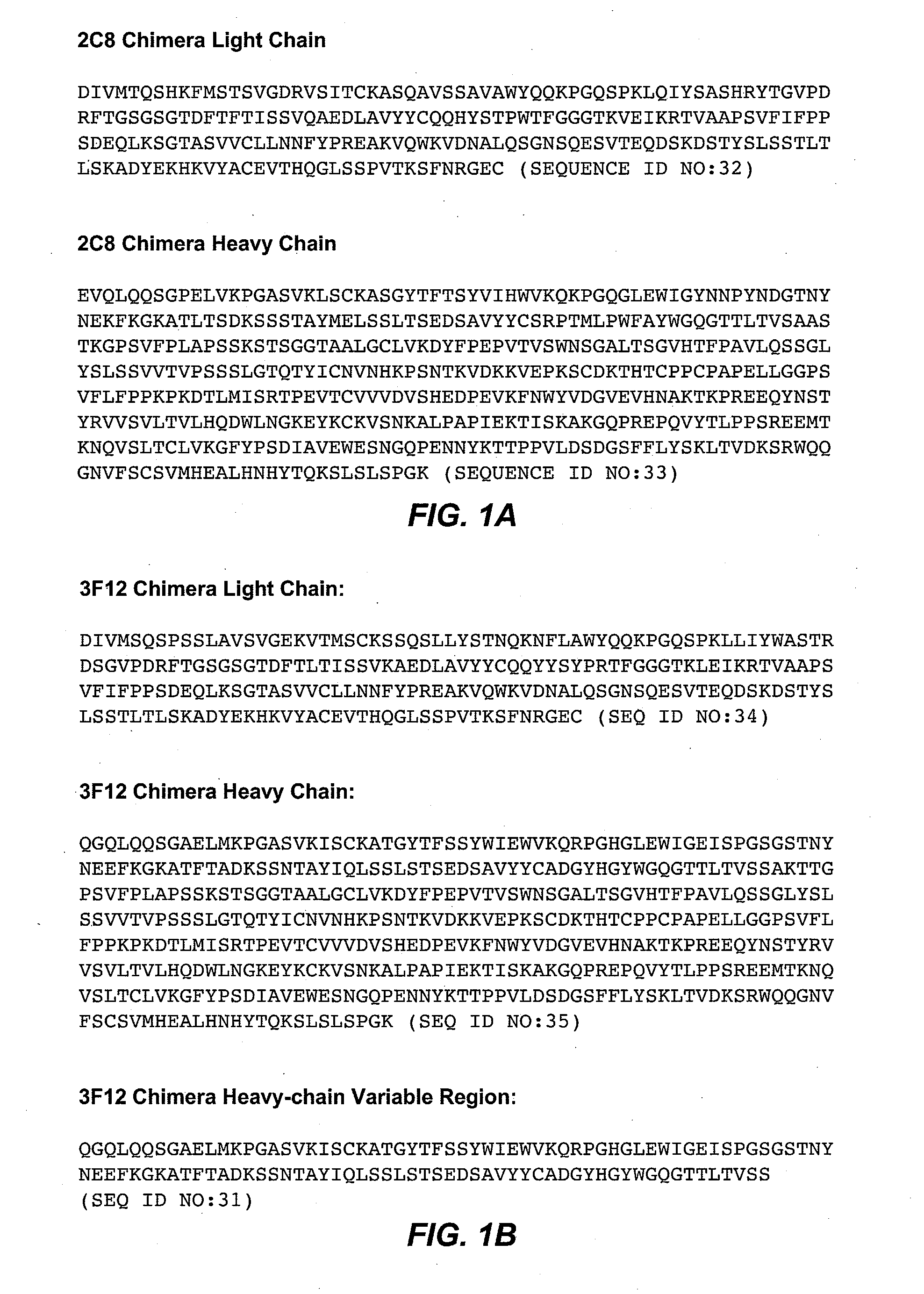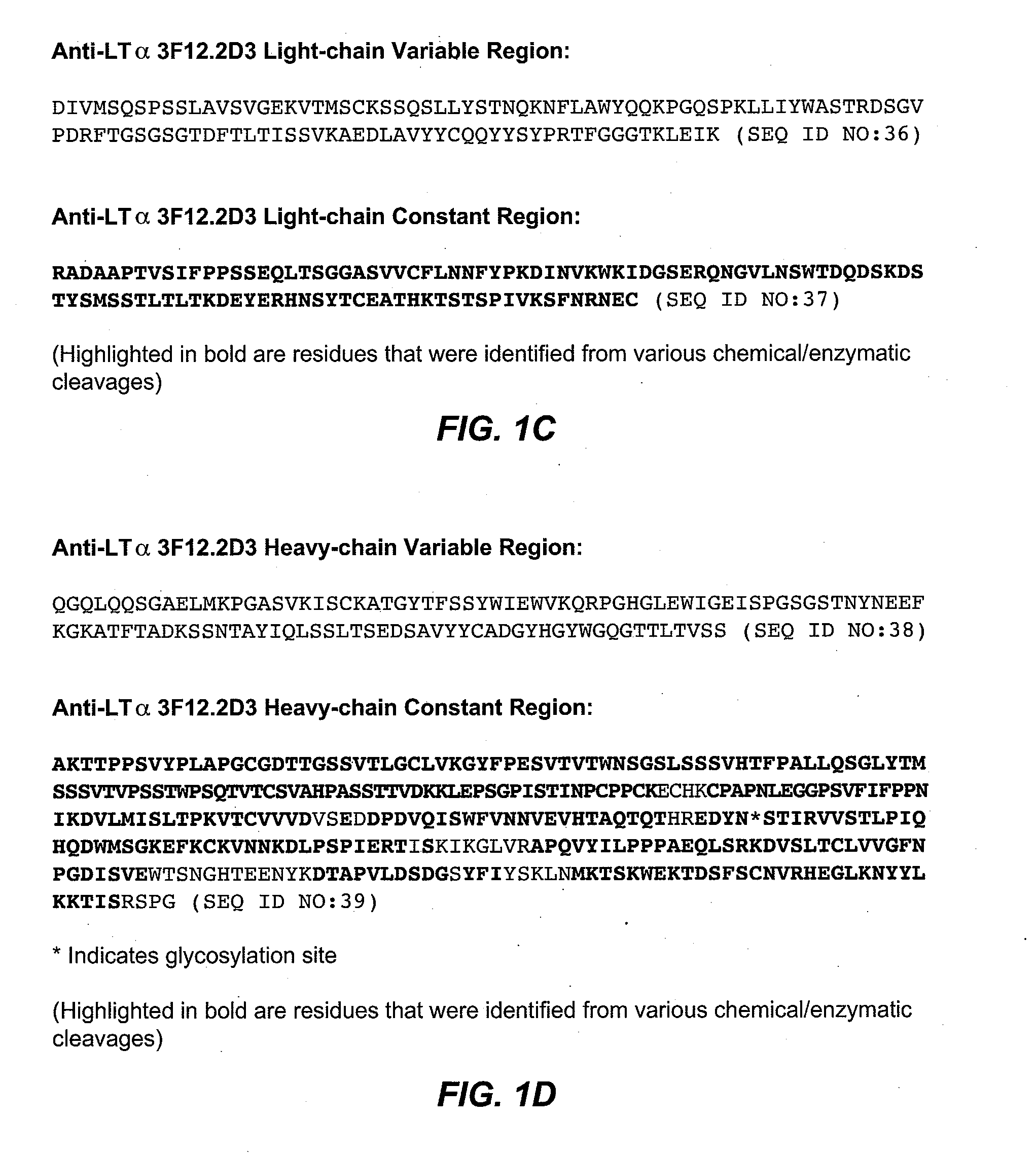Antibodies to lymphotoxin-alpha
a lymphotoxin and antibody technology, applied in the field of antibodies, can solve the problems of increasing social and financial burden, ltr-ig disrupting the lymphogenesis of mice, and uneven distribution of variability in the variable domain, so as to reduce joint damage and maintain the effect of reducing joint damag
- Summary
- Abstract
- Description
- Claims
- Application Information
AI Technical Summary
Benefits of technology
Problems solved by technology
Method used
Image
Examples
example 1
Preparation of Anti-Human and Anti-Murine Ltα Monoclonal Antibodies and Hamster-Murine Chimeras
[0516]Anti-human LTα monoclonal antibodies 2C8 and 3F12 were generated as follows: BALB / c mice (Charles River Laboratories, Wilmington, Del.) were hyperimmunized by injection with 5 μg / dose of purified recombinant human LTα expressed in E. coli (Genentech, Inc., South San Francisco, Calif.; Genentech Lot# 8360-2B; see also Spriggs, “Tumor Necrosis Factor: Basic Principles and Preclinical Studies,”Biologic Therapy of Cancer, DeVita et al., eds., J.B. Lippincott Company (1991) Ch. 16, pp. 354-377; Ruddle, Current Opinion in Immunology, 4:327-332 (1992); Wong et al., “Tumor Necrosis Factor,”Human Monocytes, Academic Press (1989), pp. 195-215; Aggarwal et al., Cytokines and Lipocortins in Inflammation and Differentiation, Wiley-Liss, Inc. 1990, pp. 375-384; and Paul et al., Ann. Rev. Immunol., 6:407-438 (1988)) in DETOX™ adjuvant (RIBI ImmunoChem Research, Inc., Hamilton, Mo.). Specifically, 1...
example 2
Sequencing, Humanization, and Affinity Maturation of Anti-LTαAntibody 3F12
1. De Novo Sequencing of Anti-LTα 3F12 Using LTQ-FTMS-MS / MS Analysis and Edman Degradation
[0526]Because the hybridoma cell line 3F12.2D3 was lost from the frozen cell line bank, anti-LTα monoclonal antibody protein, purified from ascites 3F12.2D3, was submitted for sequencing at a concentration of about 3.0 mg / mL in PBS. The antibody (Ab) was separated on 4-20% TRIS™ HCl SDS-PAGE under reducing conditions and each resolved heavy chain (HC) and light chain (LC) was subjected to N-terminal sequencing (25-30 residues were sequenced) to establish monoclonality. The HC was found to be blocked with a pyroglutamyl group that made the N-terminal amino acid inaccessible to Edman sequencing. The blocking group was subsequently removed using the pyroglutamate aminopeptidase enzyme (PGAP) and the HC chain subjected to sequencing again. Both the HC and LC were confirmed to be monoclonal. The Ab was then treated with variou...
example 3
Preparation of Chimeric Antibody 2C8 and Humanization
1. Preparation of Chimeric Antibody
[0546]The variable regions of the heavy and light chains of the murine anti-LTα antibody 2C8 that bound and neutralized LTα3 and LTαβ were cloned and formatted as a murine / human chimeric antibody essentially as described above in Example 1 for the cloning of S5H3.
[0547]For RT-PCR, the primers used were as follows:
2C8 light chain:5′ primer:(SEQ ID NO: 79)GCC ATA GAT ATC GTR ATG CAN CAG TCT C3′ primer:(SEQ ID NO: 80)TTT KAT YTC CAG CTT GGT ACC2C8 heavy chain:5′ primer:(SEQ ID NO: 81)GAT CGA CGT ACG CTG AGG TYC AGC TSC AGC TSC AGCAGT CTG G3′ primer:(SEQ ID NO: 82)ACA GAT GGG CCC TTG GTG GAG GCT GMR GAG ACD GTGASH RDR GT.
wherein K=G or T, S=C or G, D=A or G or T, M=A or C, H=A or C or T, N is T, G, A, or C (any nucleic acid of these four), R=A or G, and Y=C or T.
[0548]The variable domain of the light chain was cloned into vector pRK.LPG3.HumanKappa containing the human kappa constant domain, while th...
PUM
| Property | Measurement | Unit |
|---|---|---|
| molecular weight | aaaaa | aaaaa |
| pH | aaaaa | aaaaa |
| flow rate | aaaaa | aaaaa |
Abstract
Description
Claims
Application Information
 Login to View More
Login to View More - R&D
- Intellectual Property
- Life Sciences
- Materials
- Tech Scout
- Unparalleled Data Quality
- Higher Quality Content
- 60% Fewer Hallucinations
Browse by: Latest US Patents, China's latest patents, Technical Efficacy Thesaurus, Application Domain, Technology Topic, Popular Technical Reports.
© 2025 PatSnap. All rights reserved.Legal|Privacy policy|Modern Slavery Act Transparency Statement|Sitemap|About US| Contact US: help@patsnap.com



